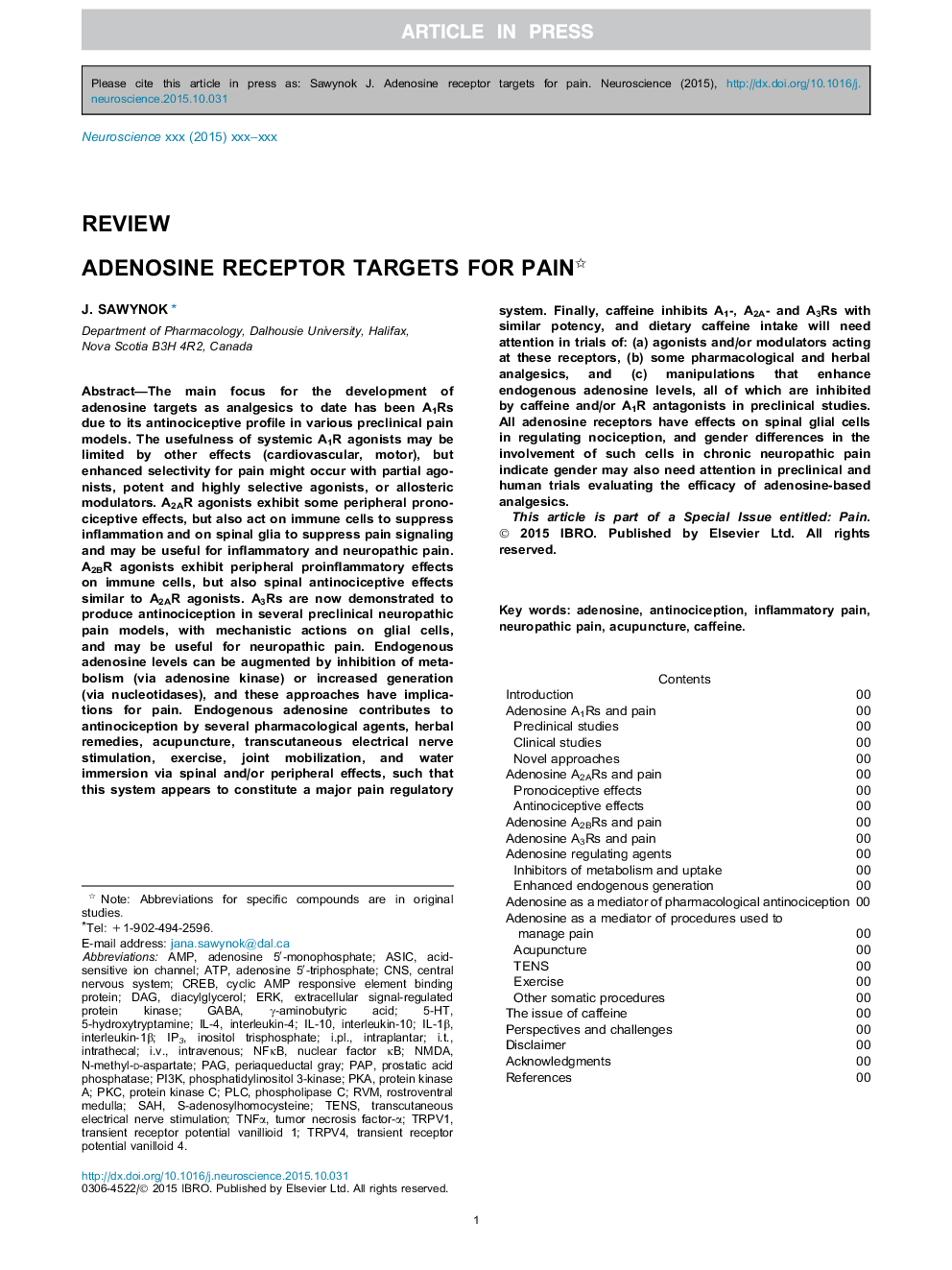| کد مقاله | کد نشریه | سال انتشار | مقاله انگلیسی | نسخه تمام متن |
|---|---|---|---|---|
| 5737908 | 1614738 | 2016 | 18 صفحه PDF | دانلود رایگان |
عنوان انگلیسی مقاله ISI
Adenosine receptor targets for pain
ترجمه فارسی عنوان
هدف گیرنده آدنوزین برای درد است
دانلود مقاله + سفارش ترجمه
دانلود مقاله ISI انگلیسی
رایگان برای ایرانیان
کلمات کلیدی
PKCInositol trisphosphatepKaIL-1βIL-10IP3NMDAN-methyl-d-aspartatePAGTRPV4PLCCREBRVMi.v.SAHASICPAPS-adenosylhomocysteinei.pl.Intraplantarrostroventral medullaPI3KERK5-HTTNFαTRPV1IL-4AMP5-hydroxytryptamineNFκB - NFKBAdenosine - آدنوزینadenosine 5′-triphosphate - آدنوزین 5'-تری فسفاتadenosine 5′-monophosphate - آدنوزین 5'-مونوفسفرهATP - آدنوزین تری فسفات یا ATPi.t. - آی تی.γ-aminobutyric acid - اسید γ-آمینوبوتیریکintrathecal - اینتراکتالinterleukin-4 - اینترلوکین -4Interleukin-10 - اینترلوکین 10Interleukin-1β - اینترلوکین-1βTranscutaneous electrical nerve stimulation - تحریک عصبی الکتریکی پوستیtumor necrosis factor-α - تومور نکروز عامل αperiaqueductal gray - خاکستری پرآبیIntravenous - داخل وریدیInflammatory pain - درد التهابیNeuropathic pain - درد نوروپاتیکCNS - دستگاه عصبی مرکزیTENS - ده هاdiacylglycerol - دیسیل گلیسیرینDAG - روزcentral nervous system - سیستم عصبی مرکزیAntinociception - ضد انعقادAcupuncture - طب سوزنی nuclear factor κB - فاکتور هسته ای κBPhosphatidylinositol 3-kinase - فسفاتیدیلینواستیل 3-کینازphospholipase C - فسفولیپاز CTransient receptor potential vanilloid 4 - پتانسیل گیرنده گذرا وانیلیوئید 4cyclic AMP responsive element binding protein - پروتئین اتصال دهنده عنصر پاسخ دهنده AMP cyclicprotein kinase A - پروتئین کیناز AProtein kinase C - پروتئین کیناز سیExtracellular signal-regulated protein kinase - پروتئین کیناز کنترل شده سیگنال غیر سلولیProstatic acid phosphatase - پروستات اسید فسفاتازCaffeine - کافئینGABA - گابا
موضوعات مرتبط
علوم زیستی و بیوفناوری
علم عصب شناسی
علوم اعصاب (عمومی)
چکیده انگلیسی
The main focus for the development of adenosine targets as analgesics to date has been A1Rs due to its antinociceptive profile in various preclinical pain models. The usefulness of systemic A1R agonists may be limited by other effects (cardiovascular, motor), but enhanced selectivity for pain might occur with partial agonists, potent and highly selective agonists, or allosteric modulators. A2AR agonists exhibit some peripheral pronociceptive effects, but also act on immune cells to suppress inflammation and on spinal glia to suppress pain signaling and may be useful for inflammatory and neuropathic pain. A2BR agonists exhibit peripheral proinflammatory effects on immune cells, but also spinal antinociceptive effects similar to A2AR agonists. A3Rs are now demonstrated to produce antinociception in several preclinical neuropathic pain models, with mechanistic actions on glial cells, and may be useful for neuropathic pain. Endogenous adenosine levels can be augmented by inhibition of metabolism (via adenosine kinase) or increased generation (via nucleotidases), and these approaches have implications for pain. Endogenous adenosine contributes to antinociception by several pharmacological agents, herbal remedies, acupuncture, transcutaneous electrical nerve stimulation, exercise, joint mobilization, and water immersion via spinal and/or peripheral effects, such that this system appears to constitute a major pain regulatory system. Finally, caffeine inhibits A1-, A2A- and A3Rs with similar potency, and dietary caffeine intake will need attention in trials of: (a) agonists and/or modulators acting at these receptors, (b) some pharmacological and herbal analgesics, and (c) manipulations that enhance endogenous adenosine levels, all of which are inhibited by caffeine and/or A1R antagonists in preclinical studies. All adenosine receptors have effects on spinal glial cells in regulating nociception, and gender differences in the involvement of such cells in chronic neuropathic pain indicate gender may also need attention in preclinical and human trials evaluating the efficacy of adenosine-based analgesics.
ناشر
Database: Elsevier - ScienceDirect (ساینس دایرکت)
Journal: Neuroscience - Volume 338, 3 December 2016, Pages 1-18
Journal: Neuroscience - Volume 338, 3 December 2016, Pages 1-18
نویسندگان
J. Sawynok,
